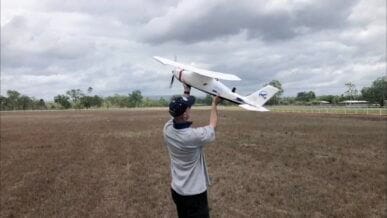Operations in Aviation are designed to allow for safe and efficient use of the airspace. In Australia, this is governed by the Civil Aviation Safety Authority (CASA) who dictate the rules and regulations surrounding all aviation, including the use of Remotely piloted aircraft systems (RPAS). Despite these rules and regulations being comprehensive, misadventures undoubtedly still occur. One of the reasons for misadventure; Rain.
The United Kingdom police force has recently discovered the detrimental effects rain has on RPAS after 16 of their department’s machines crashed, due to technical difficulties caused by wet weather. This obvious safety risk has been flagged by the UK’s aviation governing body and changes to the rules and regulations are to be implemented in 2020, but is this really going to fix the problem?
Changing the rules surrounding how and when drones can operate in rain does sound like an obvious step. However, if we took a snapshot of UK weather, wouldn’t being legally unable to fly a drone in the rain render their fleet almost entirely useless?

Regulation change does not seem like a logical solution as it would severely limit when RPAS could be operated. Instead, understanding RPAS and their specified limitations is what needs to occur; manufacturers design the machines with conditions they can be operated in and have ratings to determine conditions in which they can not be operated. Knowledge and understanding of these will reduce drone failure.

The underlying problem that exists is not aviation laws, but the drones’ IP ratings, people’s knowledge of IP ratings and how and when users choose to operate their drone despite them.
An IP rating- or the Ingress Protection marker- is a typically two-digit grading system that classifies the degree of protection provided against various types of unwanted intrusion, with the second digit representing moisture.
The purpose of an IP rating; provide users with a more detailed picture of the machines’ capabilities in rain rather than the vague marketing terms ‘water resistant’ and ‘waterproof’. Vague understanding of what the terms ‘waterproof’ and ‘water resistant’ mean, sees remote pilots operating RPAS in conditions they were not built to tolerate.
Understanding the IP rating and manufacturing specified limitations will elicit safe use of RPAS and impede preventable accidents and machine failure. A label of ‘waterproof’ does not mean the machine can fly in all amounts or directions of rain for unlimited amounts of time. Manufacturers provide an IP rating, and for its ‘moisture’ specifications the second digit of the IP number must be examined. An IP rating is designed to provide a more specific account of protection. See Table opposite for different ratings and definitions.
Although the table outlines conditions in which various machines of differing IP ratings can operate, multi rotor drones provide an additional challenge. As a remote pilot, it is important to note that the drone’s individually rotating propellers create their own vortices, altering the direction of water ingress. When understanding your drone’s IP rating, this additional challenge needs to be taken into consideration when determining if it is safe to operate the RPAS.

Ingress Protection (IP) Rating Chart
The IP ratings are universal, meaning all remote pilots worldwide would significantly benefit as a result of increased awareness and understanding of them. The reasoning behind them is so users can be confident in the safety of their machine when operating in specific environments and applications. Operating your RPAS outside of these specifications, puts yourself and others operating in the airspace in risk of danger and the pilot of the machine will be at fault. If in doubt, do not fly in the rain.
To read further recommendations regarding operational safety from the CAA, click here
